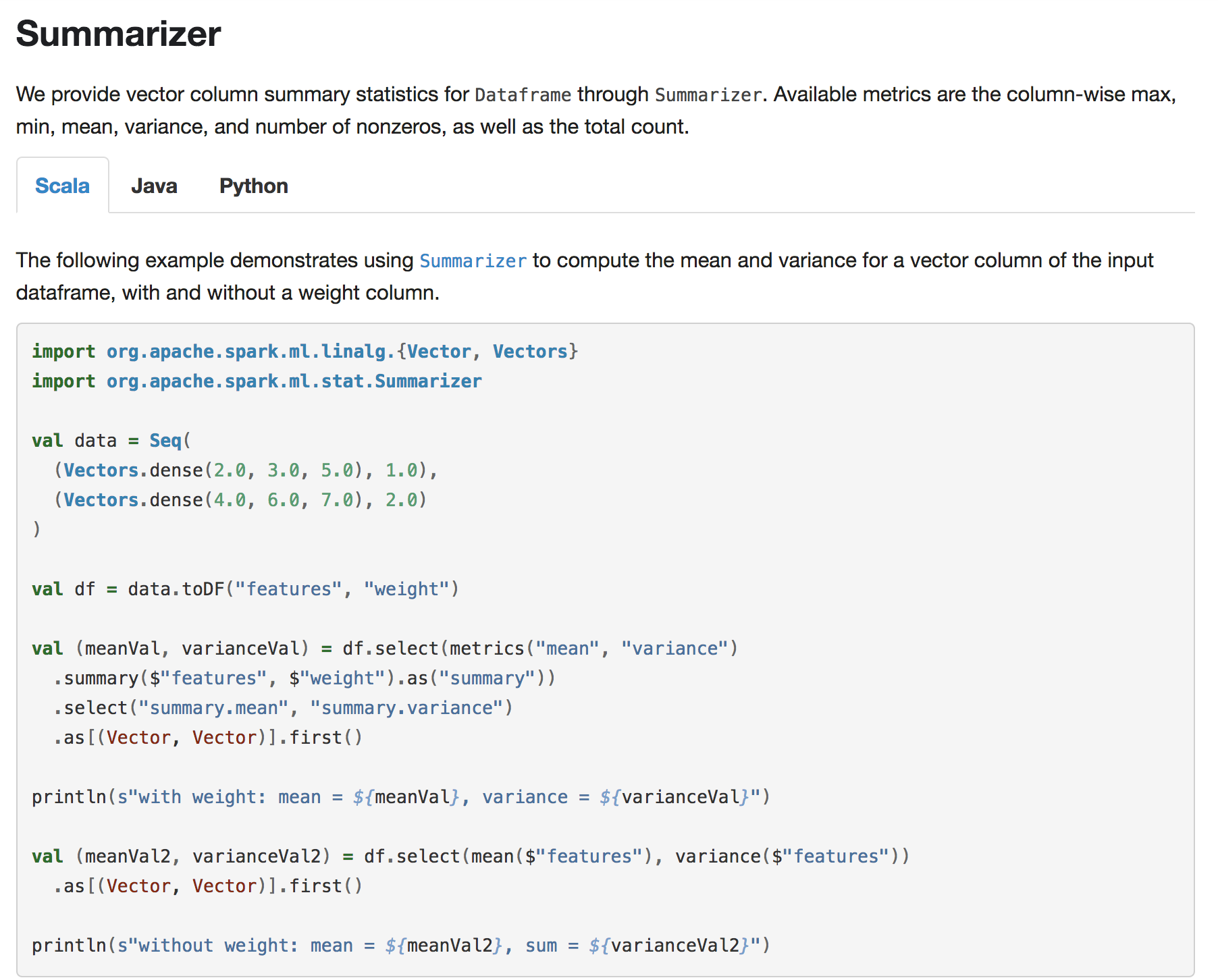## What changes were proposed in this pull request? Add user guide and scala/java/python examples for `ml.stat.Summarizer` ## How was this patch tested? Doc generated snapshot:     Author: WeichenXu <weichen.xu@databricks.com> Closes #20446 from WeichenXu123/summ_guide.
120 lines
4.4 KiB
Markdown
120 lines
4.4 KiB
Markdown
---
|
|
layout: global
|
|
title: Basic Statistics
|
|
displayTitle: Basic Statistics
|
|
---
|
|
|
|
|
|
`\[
|
|
\newcommand{\R}{\mathbb{R}}
|
|
\newcommand{\E}{\mathbb{E}}
|
|
\newcommand{\x}{\mathbf{x}}
|
|
\newcommand{\y}{\mathbf{y}}
|
|
\newcommand{\wv}{\mathbf{w}}
|
|
\newcommand{\av}{\mathbf{\alpha}}
|
|
\newcommand{\bv}{\mathbf{b}}
|
|
\newcommand{\N}{\mathbb{N}}
|
|
\newcommand{\id}{\mathbf{I}}
|
|
\newcommand{\ind}{\mathbf{1}}
|
|
\newcommand{\0}{\mathbf{0}}
|
|
\newcommand{\unit}{\mathbf{e}}
|
|
\newcommand{\one}{\mathbf{1}}
|
|
\newcommand{\zero}{\mathbf{0}}
|
|
\]`
|
|
|
|
**Table of Contents**
|
|
|
|
* This will become a table of contents (this text will be scraped).
|
|
{:toc}
|
|
|
|
## Correlation
|
|
|
|
Calculating the correlation between two series of data is a common operation in Statistics. In `spark.ml`
|
|
we provide the flexibility to calculate pairwise correlations among many series. The supported
|
|
correlation methods are currently Pearson's and Spearman's correlation.
|
|
|
|
<div class="codetabs">
|
|
<div data-lang="scala" markdown="1">
|
|
[`Correlation`](api/scala/index.html#org.apache.spark.ml.stat.Correlation$)
|
|
computes the correlation matrix for the input Dataset of Vectors using the specified method.
|
|
The output will be a DataFrame that contains the correlation matrix of the column of vectors.
|
|
|
|
{% include_example scala/org/apache/spark/examples/ml/CorrelationExample.scala %}
|
|
</div>
|
|
|
|
<div data-lang="java" markdown="1">
|
|
[`Correlation`](api/java/org/apache/spark/ml/stat/Correlation.html)
|
|
computes the correlation matrix for the input Dataset of Vectors using the specified method.
|
|
The output will be a DataFrame that contains the correlation matrix of the column of vectors.
|
|
|
|
{% include_example java/org/apache/spark/examples/ml/JavaCorrelationExample.java %}
|
|
</div>
|
|
|
|
<div data-lang="python" markdown="1">
|
|
[`Correlation`](api/python/pyspark.ml.html#pyspark.ml.stat.Correlation$)
|
|
computes the correlation matrix for the input Dataset of Vectors using the specified method.
|
|
The output will be a DataFrame that contains the correlation matrix of the column of vectors.
|
|
|
|
{% include_example python/ml/correlation_example.py %}
|
|
</div>
|
|
|
|
</div>
|
|
|
|
## Hypothesis testing
|
|
|
|
Hypothesis testing is a powerful tool in statistics to determine whether a result is statistically
|
|
significant, whether this result occurred by chance or not. `spark.ml` currently supports Pearson's
|
|
Chi-squared ( $\chi^2$) tests for independence.
|
|
|
|
`ChiSquareTest` conducts Pearson's independence test for every feature against the label.
|
|
For each feature, the (feature, label) pairs are converted into a contingency matrix for which
|
|
the Chi-squared statistic is computed. All label and feature values must be categorical.
|
|
|
|
<div class="codetabs">
|
|
<div data-lang="scala" markdown="1">
|
|
Refer to the [`ChiSquareTest` Scala docs](api/scala/index.html#org.apache.spark.ml.stat.ChiSquareTest$) for details on the API.
|
|
|
|
{% include_example scala/org/apache/spark/examples/ml/ChiSquareTestExample.scala %}
|
|
</div>
|
|
|
|
<div data-lang="java" markdown="1">
|
|
Refer to the [`ChiSquareTest` Java docs](api/java/org/apache/spark/ml/stat/ChiSquareTest.html) for details on the API.
|
|
|
|
{% include_example java/org/apache/spark/examples/ml/JavaChiSquareTestExample.java %}
|
|
</div>
|
|
|
|
<div data-lang="python" markdown="1">
|
|
Refer to the [`ChiSquareTest` Python docs](api/python/index.html#pyspark.ml.stat.ChiSquareTest$) for details on the API.
|
|
|
|
{% include_example python/ml/chi_square_test_example.py %}
|
|
</div>
|
|
|
|
</div>
|
|
|
|
## Summarizer
|
|
|
|
We provide vector column summary statistics for `Dataframe` through `Summarizer`.
|
|
Available metrics are the column-wise max, min, mean, variance, and number of nonzeros, as well as the total count.
|
|
|
|
<div class="codetabs">
|
|
<div data-lang="scala" markdown="1">
|
|
The following example demonstrates using [`Summarizer`](api/scala/index.html#org.apache.spark.ml.stat.Summarizer$)
|
|
to compute the mean and variance for a vector column of the input dataframe, with and without a weight column.
|
|
|
|
{% include_example scala/org/apache/spark/examples/ml/SummarizerExample.scala %}
|
|
</div>
|
|
|
|
<div data-lang="java" markdown="1">
|
|
The following example demonstrates using [`Summarizer`](api/java/org/apache/spark/ml/stat/Summarizer.html)
|
|
to compute the mean and variance for a vector column of the input dataframe, with and without a weight column.
|
|
|
|
{% include_example java/org/apache/spark/examples/ml/JavaSummarizerExample.java %}
|
|
</div>
|
|
|
|
<div data-lang="python" markdown="1">
|
|
Refer to the [`Summarizer` Python docs](api/python/index.html#pyspark.ml.stat.Summarizer$) for details on the API.
|
|
|
|
{% include_example python/ml/summarizer_example.py %}
|
|
</div>
|
|
|
|
</div> |